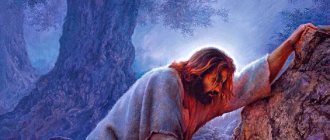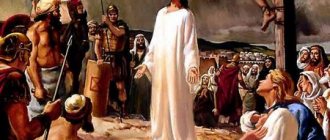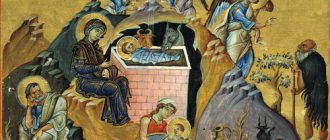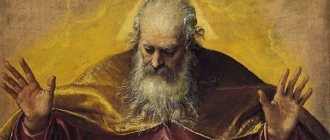Personal attribute of God the Father
Metropolitan Macarius (Bulgakov). Dogmatic Theology
The teaching of the Orthodox Church about the personal property of God the Father has the firmest foundations in St. Scripture. These include:
a) the words of the Savior: just as the Father had life in himself, so He gave the Sons also life in themselves (John 5:26), from which it is clear that the Father did not receive being from anyone, was not created from anyone, was not begotten and did not comes out; b) all those places where He is called the Father in relation to the Son, of which there are countless numbers, for example: no one knows the Son except the Father; no one knows the Father except the Son, and whatever the Son wills to reveal (Matthew 11:27); that you may honor the Son as you honor the Father, and whoever does not honor the Son does not honor the Father who sent him (John 6:23); or where it is said that He gives birth to a Son: The Lord said to me: You are my son, I have given birth to you today (Ps. 2:7); from the womb before the morning star I gave birth to you (Ps. 109:3); c) finally, places representing the Father as the beginning in relation to the Holy Spirit: when the Comforter comes, whom I will send to you from the Father, the Spirit of truth, who proceeds from the Father, testifies about me (John 15:26); We do not receive the spirit of this world, but the Spirit who is from God (1 Cor. 2:12).
From here -
a) it becomes clear why the Father usually occupies first place in the order of Divine Persons (Matthew 28:19) and is called the first Hypostasis of the Holy Trinity, or, as sometimes among the ancients, self-god, first-god, initial God, and so on. ; b) it is also clear that in God there is only one beginning of the Divinity, the Father, a thought that was very often repeated by ancient teachers and is still maintained by the Orthodox Church: for the Son and the Holy Spirit receive their existence from Him alone; c) it is clear, finally, that the Father serves as a kind of connection and unity for the Persons of the Holy Trinity, who, although one in essence, are separate as Persons: for the Son and the Holy Spirit, receiving the beginning from Him, are raised to Him alone , as to his Culprit.
“Nature is in Three,” writes St. Gregory the theologian, the one is God, the unity is the Father, from whom are the Others, and to which They are raised, not merging, but co-abiding with Him, and not separated from each other by time, desire, or power” (Homily 42, in Creation. St. Father IV, p. 38; demolished II, p. 168: “according to my reasoning, faith in one God is observed when we attribute both the Son and the Spirit to the one Author (but not add them up or confuse them with Him) - to relate both according to the same (I will call it that) movement and will of the Divine, and according to the identity of essence").
And in order to correctly represent the personal property of God the Father, we must remember the remarks of the ancient teachers of the Church that He begets the Son and produces the Holy Spirit:
a) in a completely spiritual way, and therefore, without any suffering, without any sensory separation: because the nature of God is immaterial and simple; b) gives birth and produces from eternity and forever: for there was no time when the Father was not the Father of the Son and Producer of the Holy Spirit, just as there was no time when He was not God, and what never began cannot be said so that it ends; c) gives birth and produces in such a way that He alone knows and He who is born from Him and He who proceeds knows, but none of the creatures can comprehend; d) finally, that originlessness and guiltlessness are exclusively assimilated to God the Father only in relation to the other Persons of the Holy Trinity, and according to Divinity, both the Son and the Holy Spirit are without beginning and guiltless, or better yet, the entire Holy Trinity is without origin and guiltless.
Historical era
The country in which Christ was born and lived was seething and full of expectations. In 63 BC. e. Roman commander Pompey captured Jerusalem. This put an end to the brief political independence of the Israelis - from then on there was a permanent Roman garrison in Jerusalem. The Romans could not understand the religion of the Jews, seeing in it only a mixture of prejudices and barbaric customs. They tried to convert the Israelis to their faith, insulted them, subjected them to robbery and extortion. The Jews hated the Romans and often rebelled against their rule. In 40 BC. e. With the blessing of the Romans, a native of the country, Herod the Great, who was distinguished by his extremely cruel disposition, became king of Judea. During his reign, the spread of Hellenistic culture continued in Judea. Fearing the loss of power, he flooded the country with secret spies and severely punished every Jew on whom even the shadow of suspicion of treason fell. Fearing betrayal even in his own family, he killed his two sons and his wife. After his death, the country was divided between his two sons, whom the people treated with the same hatred as Herod himself. In 6 AD e. Jerusalem and Judea came under direct control of Rome. Governors and procurators sent from Rome began to rule the country. The Jews dreamed of deliverance from the hated yoke of the Romans. Some of them united into original parties. For example, the Zealots were going to achieve liberation through an armed uprising and struggle. They called on the people not to pay taxes to the Romans. The Zealots became the basis of the liberation movement, which was defeated in 73 AD. e.
For Jews this was a time of religious quest. There was a split into religious groups. One of the groups that we often see mentioned in the New Testament was called the Pharisees. This direction united the laity, people who did not have holy orders. The Pharisees called their mentors “rabbi,” which means “teacher.” They introduced many new ideas into the ancient teaching, such as ideas about life after death, angels and demons, as well as the fact that history is driven by Divine providence. They tried to reinterpret the Torah in relation to the changing needs of people. However, this led to an endless proliferation of rules that were difficult to follow and to accusations of excessive legalism. After the fall of Jerusalem in 70 AD. e. The Pharisees became the mainstay of Judaism. Another important group were the Sadducees, a conservative party of the aristocracy. The ruling elite of society consisted primarily of representatives of this particular group. Religiously and politically, they adhered to extremely conservative views and opposed the reform-minded Pharisees. They interpreted the Law of Moses literally and apparently did not believe in life after death. After the fall of Jerusalem and the destruction of the Temple, they lost their power and influence. In addition, there were other spiritual groups. The most famous among them were the Essenes who lived in the desert - an ascetic religious community whose members were subject to very strict requirements. The Essenes condemned the corruption of the Temple priests. They were preparing for the coming of the Messiah, who was supposed to lead them to fight against the tyranny of the Roman Empire and for the restoration of the Kingdom of Israel.
Doctrine of the Monarchy of the Father
Oleg Davydenkov (Dogme. Theology. Course of lectures)
This question is divided into two sub-questions:
1) are we not humiliating the second and third hypostases, affirming the monarchy of the Father? and 2) why is the doctrine of the monarchy of the Father of such fundamental importance, why have the holy fathers of the Orthodox Church always insisted on such an understanding of the Trinity relationship?
The unity of power of the Father in no way diminishes the Divine dignity of the Son and Spirit. The Son and the Holy Spirit by nature possess everything that is inherent in the Father, with the exception of the property of ungeneracy. But the property of unbornness is not a natural property, but a personal, hypostatic one; it characterizes not nature, but the way of its existence.
St. John of Damascus says about this: “Everything that the Father has, both the Son and the Spirit have, except ungeneracy, which does not mean a difference in essence or dignity, but a mode of being.” V.N. Lossky tries to explain this somewhat differently (Essay on the mystical theology of the Eastern Church. Dogmatic Theology. M., 1991): “The beginning is only perfect when it is the beginning of an equally perfect reality. In God, the cause, as the perfection of personal love, cannot produce a less perfect effect; it wants them to be equally honest, and therefore is also the cause of their equality.” St. Gregory the Theologian (Homily 40 on Epiphany) says: “There is no glory to the Beginning (i.e., the Father - O.D.) in the humiliation of those who are from Him.”
Why did the Eastern Church Fathers insist on the doctrine of the monarchy of the Father? To do this, we need to remember what the essence of the Trinitarian problem is: how to simultaneously think in God both trinity and unity, and so that one is not affirmed to the detriment of the other, so that by affirming unity, not merging the Persons and affirming the differences of Persons, not dividing the single essence . The Holy Fathers called God the Father Divinity the Source. For example, St. Gregory Palamas in his confession says: “The Father is the only cause and root and source, in the Son and Holy Spirit of the contemplated Divinity.” As the Eastern Fathers put it, “there is one God because there is one Father.”
It is the Father who communicates his one nature equally, although in different ways, to the Son and the Holy Spirit, in whom it remains one and indivisible. At the same time, the absence of a relationship between the Holy Spirit and the Son has never confused Eastern theology, since a certain correlation is also established between the Son and the Holy Spirit, not directly, but through the Hypostasis of the Father; it is the Father who supplies the Hypostases in their absolute distinction. At the same time, there is no direct relationship between the Son and the Spirit. They differ only in the mode of Their origin.
According to V.N. Lossky (Essay on the mystical theology of the Eastern Church. Dogmatic theology. M., 1991, p. 47): “The Father is thereby the limit of the relationships from which the Hypostases receive their distinction: giving the Persons their origin, the Father establishes their relationship with the single beginning of the Divinity as birth and being." Since the Son and the Holy Spirit simultaneously ascend to the Father as one cause, then for this reason they can be thought of as different Hypostases.
At the same time, arguing that birth and procession, as two different ways of origin of Divine Persons, are not identical to each other, Orthodox theologians, in accordance with the tradition of apophatic theology, reject any attempts to establish what exactly this difference is. St. John of Damascus writes that “of course, there is a difference between birth and procession - we have learned this, but what kind of difference we do not comprehend.” Any attempt to somehow abolish or weaken the principle of unity of command inevitably leads to an imbalance in the Trinity, the balance between trinity and singularity. The most striking example of this is the Latin doctrine of the filioque, that is, of the double procession of the Holy Spirit from the Father and the Son as a single cause.
Brahman
In the ancient Indian philosophical school there was a concept of the One similar to the Greek one - the Indians called it Brahman. They believed that our entire world in all its diversity: every leaf on a tree, every pebble on the ground, every living creature, every moment of time, are particles of a certain superbeing - Brahman, and all physical, chemical, biological and historical processes in The Universe are the life processes of this super being. This being is not a personal God, Brahman is rather the soul of the world, an indifferent absolute, it is directly reality itself. This creature did not appear from anywhere, and will not disappear anywhere, it is existence itself. They argued that Brahman cannot be given any affirmative definition, it can only be defined through negation: Brahman is infinite, Brahman is unchanging, Brahman is motionless. The ancient Indians, who believed in Brahman, were the first pantheists.
It is interesting to note that the famous physicist Erwin Schrödinger was an ardent admirer of the Indian philosophical school of Vedanta and wrote an entire treatise on the connection between quantum mechanics and Brahman. But unlike Schrödinger, not all philosophers of ancient India agreed with the idea of Brahman, and one of them will be discussed further.
Why are images of God the Father on icons and frescoes called non-canonical?
Because the image of God the Father contradicts the decisions of Church Councils. Thus, the holy fathers of the Seventh Ecumenical Council decided: “Why do we not describe the Father of the Lord Jesus Christ? Because we haven't seen Him. And if we saw and knew Him, as well as His Son, then we would try to describe and pictorially depict Him (the Father) too...” (Acts of the VII Ecumenical Council, Act 4).
The Council of the Hundred Heads, convened in Moscow in 1551, giving instructions to icon painters, determined in its 43rd rule the fundamental non-representability of the Divine. This was also confirmed by the Great Moscow Council, which met in 1666–1667. In the 43rd chapter of the acts of this Council, which is called “On icon painters and Hosts,” a very clear decree was given: “from now on, the image of the Lord Hosts should not be painted in absurd and indecent visions, for no one has seen Hosts in the flesh, as is depicted , that is, depicted according to the flesh, and not according to the Divine. The Lord of hosts is gray-haired and the Only Begotten Son in His womb to write on icons and a dove between Them is extremely absurd and indecent.”
How do theology and philosophy define the essence of the Lord?
The approaches of religion and science to this problem are different. The term " theology"
" is generally considered to be a translation from the Greek concept of "theology", but is not essentially accurate. Closer in meaning is the word “divine knowledge” (knowledge). It does not explain exactly who God is, because human words cannot do so.
It's like trying to tell a person what the color green looks like, for example, or the note "F" sounds. They can only be seen or heard. Likewise, the vision of the Creator can be understood, or rather, experienced only through His actions.
Considering this subject, philosophy defines it to a generalized extent as a person, a being with supernatural properties. It is believed that it is not possible to give an absolutely accurate definition here.
God cannot be comprehended with the help of human intellect, but only through spiritual approach
to His truth, by feeling. Referring to biblical sayings, the Creator is invisible to our eyes and can only be revealed to those people who deserve it.
"Divine" creation of the Universe from the point of view of science
From time immemorial, humanity has been interested in the question of how the world around it came into being and who “had a hand” in it.
There are different views and theories: natural science, philosophy, theology, including the beliefs of a number of scientists who combine the positions of both science and religion.
There is an interesting opinion about how they differ. It is based on different understandings and interpretations of the same event, for example, the movement of a ship or a car. You can explain the reason for the operation of the motor, as a result of which a ship floats or a car drives, or you can justify the need for this trip. Simply put, in the first case we will answer the question “how, why?”, and in the second - “for what, why?”, but this is a first approximation.
If we take into account the reasons for the emergence of the world, the universe, then more complex worldview problems will arise that can be explained both from the point of view of science (in the form of the “big bang” theory) and from the position of divine influence on the transformation of chaos into the legitimate being.
Trying to explain the full complexity of the functioning of the universe is possible, most likely, by combining these two approaches together.
If you start talking about the complex matters of the origin of our life and its meaning, then with a high probability you will come to think: how did God appear, and if He is not involved in this, then who and where did he come from? We tried to help you with this.







